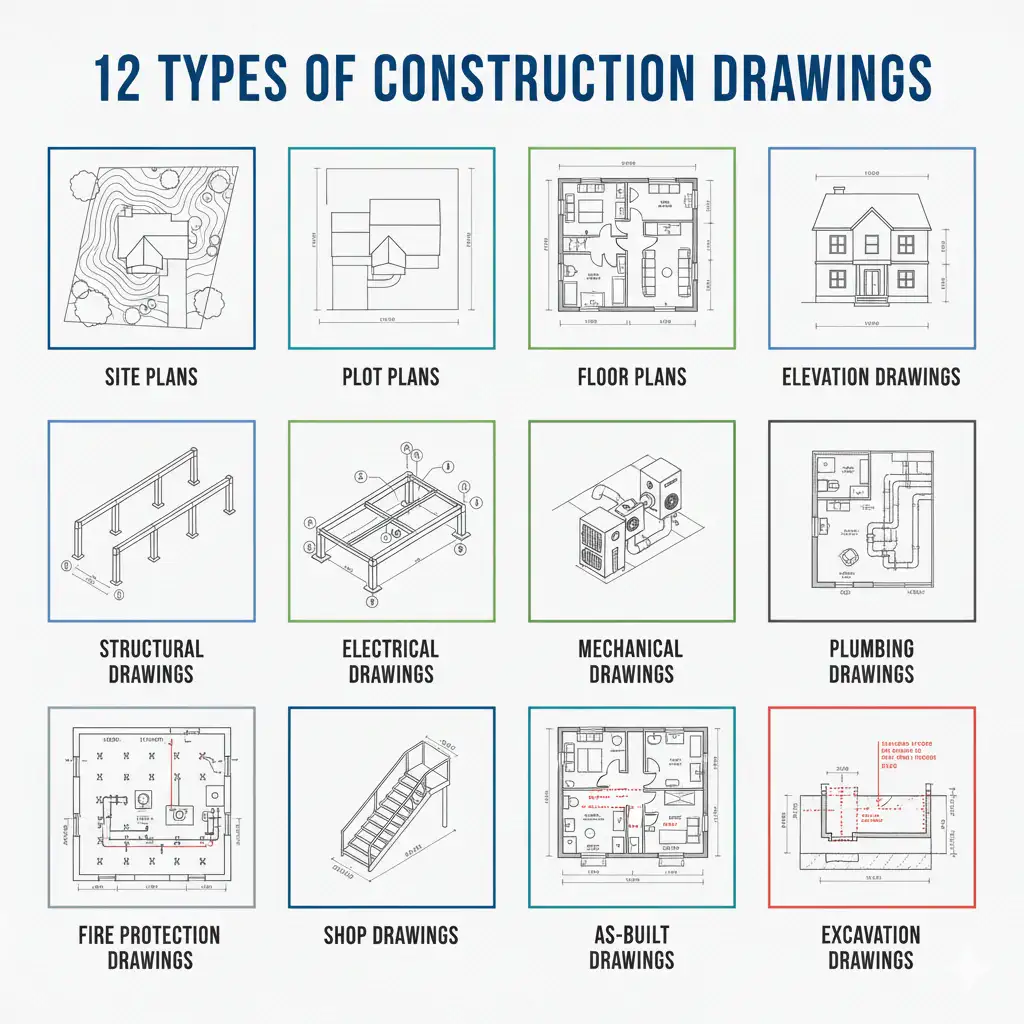There are various types of construction drawings, and we are going to discuss the main twelve in this guide. Before that, you need to know that construction drawings are the main reason behind every successful project. For AEC experts, the drawings are like the universal language. It guarantees accuracy and proper documentation.
Well, to become an engineer, you must know how to read construction blueprints error-free. Otherwise, a minor mistake can result in inaccurate cost estimates and planning. Now, let’s discuss the major types of construction drawings.
READ OUR COMPREHENSIVE GUIDE TO LEARN ABOUT THE MAJOR CONSTRUCTION DRAWINGS AND WHAT THEY ARE USED FOR!
12 Types of Construction Drawings
1. Site Plans
A site plan provides an overview of the entire project site. It shows the layout and the boundaries of the building. However, this drawing type functions as a detailed map of the project location before construction begins. The major part of these plans is:
- Property lines and boundaries
- Existing and proposed structures
- Access points and driveways
- Drainage systems
- Landscaping features
- Neighboring structures and topography
3D Site plans provide a more realistic view with elevations and depths. Professional firms often offer site plan rendering services to help clients visualize the entire project layout before construction begins.
2. Plot Plans
Plot plans are similar to site plans. It analyzes the whole project using an aerial view. It provides a more detailed view of the land where the structure will be. Architects and designers use this plan to get an idea about the boundaries of the land.
3. Floor Plans
A floor plan is basically a top-down picture of a building. You can see where the walls are. Plus, the size of doors and windows. Architects also analyze the dimensions of every room through these plans.
Purpose:
- Showroom arrangements and dimensions
- Indicate door and window placements
- Display wall configurations
- Illustrate traffic flow patterns
- Enable builders, engineers, and architects to understand structural details and spatial organization
4. Elevation Drawings
An elevation drawing is a two-dimensional representation of one side of a building. It shows:
- It shows the finished look of the building. Experts can also view important vertical measurements. It includes ceiling heights, the total height of the walls, and the location of the roofline.
- It clearly shows the appearance of features like doors and windows, etc.
- It illustrates the inner construction details, such as the foundation and how the walls and framework are built.
5. Structural Drawings
Structural drawings showcase building frameworks which is drawn by experts. These types of drawings provide views on concrete footings, wall-to-roof connections, etc. Its main components are:
- Load-bearing walls
- Steel beams
- Foundation details
- Concrete reinforcement specifications
- Connection details between structural elements
6. Electrical Drawings
Electrical drawings include information about different elements like power outlets, light fixtures, etc. All the wiring systems and other electrical work are based on these drawings.
Experts provide accurate electrical blueprint estimation by analyzing the following components through the drawings:
- Power distribution systems
- Lighting plans and fixture locations
- Circuit diagrams and panel board layouts
- Cable tray routes
- Fire alarm systems
- Communication networks
- Emergency backup power systems
7. Mechanical Drawings
Mechanical drawings showcase the layout of HVAC systems. Ductwork and air ventilation systems are dependent on these types of drawings. Builders rely on mechanical drawings to work on the following components:
- Heating and cooling equipment placement
- Ductwork layouts and routing
- Ventilation points and exhaust systems
- Thermal zones
- Equipment schedules with manufacturer specifications
8. Plumbing Drawings
Plumbing drawings are helpful to architects and builders to know the plan of water supply, drainage, and sewage systems. In these drawings, points are marked for sinks, pipes, materials, etc. For plumbing systems, this information is necessary:
- Pipe layouts and sizing
- Water supply and distribution systems
- Drainage lines
- Fixture locations
- Valves and pumps
- Drainage slopes and venting requirements
- Backflow prevention devices
Mechanical, Electrical, and Plumbing drawings are collectively known as MEP drawings, which play a vital role in building systems coordination. If you want to explore each category in depth, check out our detailed guide on MEP drawing types.
9. Fire Protection Drawings
Fire protection drawings are also quite important for every type of building. It helps to allocate points for water outlets and fire escapes. An experienced construction estimating company balances the budget from such drawings. The accurate cost estimates are helpful for the successful installation of:
- Fire sprinkler system layouts
- Fire hose and hydrant locations
- Emergency exit routes and fire escapes
- Fire alarm system placement
- Smoke detection equipment
- Fire suppression systems
- Safety equipment locations
10. Shop Drawings
Shop drawings are construction drawings that are helpful to experts for prefabricated components. It consists of detailed information about:
- Elevators
- structural steel
- Trusses
- pre-cast concrete
- windows, etc.
The manufacturer reads all the drawings carefully and makes the installation easy!
11. As-Built Drawings
As-built drawings are the final blueprints. They show how a building will look after all the work is finished. They are also referred to as record drawings because they document the outcome. They are important because:
- Document the final construction reality
- Incorporate changes made during construction
- Serve as a reference for future renovations
- Essential for facility management and maintenance
- Critical for suppliers creating future modifications
12. Excavation Drawings
These plan drawings show the dimensions of the excavation. It helps to identify the precise depth, width, and length of the excavation for construction. It provides the following information:
- Excavation boundaries and depths
- Soil removal specifications
- Foundation elevation requirements
- Grading plans
- Shoring and support requirements
- Drainage considerations during excavation
Conclusion
Understanding these 12 types of construction drawings is important for AEC experts. Every drawing has its own purpose. A professional architectural drafting company or design firm provides error-free plans so that the projects execute successfully. So, it is better to seek help from experts to move on to the next construction process without any hurdles.

